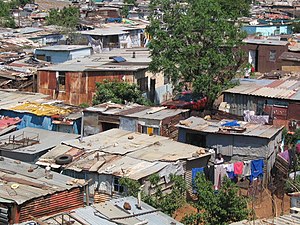Slum clearance in South Africa
Slum clearance in South Africa has been used as an urban renewal strategy to regenerate derelict or run-down districts, often to be replaced with alternative developments or new housing.
Context
In 1938, a significant scheme was initiated in Cape Town which involved the construction of around 12,000 houses at a cost of £6,000,000 ($30,000,000). The worst slum district, district VI, was part of the first phase which involved building the equivalent of a new town to house 31,000 people.[1] The city council was given permission by the Central Housing Board to include as many four-storey blocks of flats as it desired[2] and by 1942 was set to construct 13,000 dwellings as part of clearance projects.[3]
Post war
In the mid-1950s, the city of Johannesburg was reported to have the world's worse slums.[4] There were concerns around black people moving to urban area searching for work, which created overcrowding and disease, as well as juvenile delinquency as a result of lack of accommodation in schools. Such conditions would result in slums and once considered too "squalid", would be taken over by city planners and removed.[5] The city council agreed to a government initiative titled "Site and Service", a slum clearance scheme whereby evicted families would be designated accommodation with a lavatory and a communal water supply.[4] In Sophiatown, 2,000 armed police would surround the area and 150 families at a time would be given eviction notices with just 12 hours to leave. Families were relocated 12 miles beyond the city limits and their former homes were demolished immediately after they vacated. Under Apartheid, the families evicted were black and deemed unfit to reside in the city, yet were relocated close enough that they could still commute to work.[6] When Sophiatown was "removed", the residents were reported to have left "quietly, almost happily" on government-provided transport to their new homes, with armed police who had been sent in anticipation of needing to quell riots standing idle.[5] A program to deliver 30,000 homes, part of a wider slum clearance plan got underway in 1957.[7]
By the early 1970s, South Africa was well advanced into various major clearance projects. In Umlazi, just south of Durban, 20,000 new bungalows were laid out in a style reminiscent of California. The new properties were available for $10 monthly rent.[8] Similar housing projects, but on a considerably larger scale, were happening in Soweto. The country by this time had a wide ranging clearance program, with many remaining slums being prepared for demolition. The progress in clearing slums and their replacement offered a clear contrast to the shacks and hovels that prevailed during this time in most major African cities.[9]
Ethnic divisions
Reports in 1959 suggested that some slums vacated by native Africans, particularly in the city of Pretoria, were being subsequently populated by poor white families rather than being demolished.[10] In contrast, some districts of a predominant white population had been known to expand into a location previously reserved for natives. On some occasions, churches were a victim of this expansion, having initially been built cheaply or at no cost and therefore not being entitled to much if any compensation, yet to reconstruct it in a new location "may cost several hundred times as much as the compensation received for the old", due to municipal laws requiring formal planning on new building construction.[11]
See also
References
- ^ "Capetown Starts Slum Clearance". The Calgary Daily Herald. 16 April 1938. p. 22.
- ^ "Capetown opens big program in slum clearance". The Edmonton Bulletin. 16 April 1938. p. 5.
- ^ "Slum Clearance: New Dwellings in Cape Town". The Windsor Star. 5 June 1942. p. 13.
- ^ a b "S. Africa sets slum clearance". Washington Afro-American. 16 August 1955. p. 11.
- ^ a b "Book of the week: Slum clearance". The Calgary Herald. 16 June 1956. p. 4.
- ^ "Swimming against the good tide". The Montreal Gazette. 10 February 1955. p. 8.
- ^ "Slum clearance drive begins in South Africa". The Afro American. 6 April 1957. p. 39.
- ^ "South Africa Steps Gingerly Toward Black-White Amity". St. Petersburg Times. 30 August 1971. p. 18.
- ^ "South Africa: The Concentration Camp That Isn't". The Bradenton Herald. 30 August 1971. p. 4.
- ^ "Moving In". The Tampa Tribune. 15 December 1959. p. 33.
- ^ "Injustice". The News Journal. 8 March 1963. p. 21.
